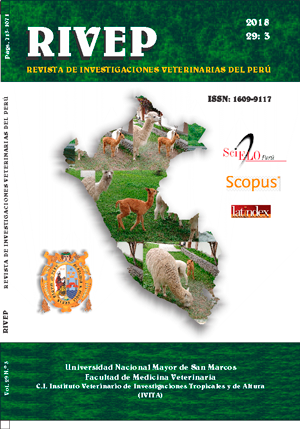Productive performance, ruminal degradation and in vitro gas production in sheep fed diets based on post-harvest residues of Chenopodium quinoa
DOI:
https://doi.org/10.15381/rivep.v29i3.14836Keywords:
digestibility, gas production, in vitro, in situ, voluntary intake, sheepAbstract
The aim of the study was to determine the effect of the post-harvest residue intake of Chenopodium quinoa on the productive performance, apparent digestibility of dry matter (DM), ruminal degradation of DM and in vitro gas production in sheep. A group of 12 rams of 6 months were used to evaluate body weight gain and voluntary consumption for 75 days (15 days of adaptation) and in vivo digestibility in metabolic cages. A second group of 6 sheep over 8 months of age and rumen cannulated were used for the study of in situ ruminal degradation of DM using the nylon bag technique and for in vitro gas production. A randomized design with two treatments was used: T1: (95.8% Pennisetum clandestinum), T2: (75.8% P. clandestinum and 20% bran of C. quinoa). Voluntary intake in T2 was higher than in T1, but voluntary intake per kg PV0.75 showed no significant difference between treatments. The feed conversion was better in T2 versus T1 (7:91 to 9:29). The weight gain was higher in T2. The apparent digestibility of the DM did not show differences between treatments. In vitro gas production was lower in T2 with respect to T1. The parameters of ruminal degradation did not show differences between treatments. With respect to the rate of degradation (c) in percentage per hour no differences were observed between forages. It is concluded that forage residues of C. quinoa can be included in 20% of the diet of sheep for moderate body weight gain when using low nutritional quality pastures such as P. clandestinum.Downloads
Downloads
Published
Issue
Section
License
Copyright (c) 2018 Oscar P. Núñez Torres, Marcos-Barros Rodriguez, Daniela Sanchez, Carlos Guishca-Cunuhay

This work is licensed under a Creative Commons Attribution-NonCommercial-ShareAlike 4.0 International License.
AUTHORS RETAIN THEIR RIGHTS:
a. Authors retain their trade mark rights and patent, and also on any process or procedure described in the article.
b. Authors retain their right to share, copy, distribute, perform and publicly communicate their article (eg, to place their article in an institutional repository or publish it in a book), with an acknowledgment of its initial publication in the Revista de Investigaciones Veterinarias del Perú (RIVEP).
c. Authors retain theirs right to make a subsequent publication of their work, to use the article or any part thereof (eg a compilation of his papers, lecture notes, thesis, or a book), always indicating the source of publication (the originator of the work, journal, volume, number and date).










